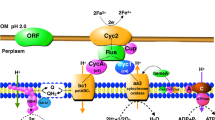Abstract
A method is described for the determination of Fe2+ and Fe3+ after its reduction to Fe2+ on the basis of oxygen uptake rate as a function of Fe2+ concentration. By using substratespecificThiobacillus ferrooxidans in combination with the standard addition method a specific determination of iron(II,III) is possible with the determination limit of 3 ámol/L.
Similar content being viewed by others
References
Drierley C. L.: Bacterial leaching.CRC Crit. Rev. Microbiol.6, 207 (1978).
Bin G. A., Suzuki I.: Mechanism of Fe2+ cytochromec reductase ofFerrobacillus ferrooxidaus. Can. J. Biochem.45, 1547 (1967).
Din G. A., Suzuki I., Lees H.: Ferrous iron oxidation byFerrobacillus ferrooxidans. Purification and properties of Fe2+ cytochrome reductase.Can. J. Biochem.45, 1523 (1967).
Holzbecher Z., Jeník J., Šůcha L., Vláčil F., Vrbský J.:Analytical Chemistry, p. 312. (In Czech) SNTL, Prague 1968.
Jílek R., Beranová E., Mandl M.: Isolation and identification of autotrophic thiobacilli. (In Czech) Project report, Veterinary Research Institute, Brno 1981.
Koch O. G., Koch-Dedic G. A.:Handbuch der Spurenanalyse, Teil 2. Springer-Verlag, Berlin-Heidelberg-New York 1974.
Lacey D. T., Lawson F.: Kinetic of the liquid-phase oxidation of acid ferrous sulfate by the bacteriumThiobacillus ferrooxidans.Biotechnol. Bioeng.12, 29(1970).
Lazaroff N.: Sulfate requirement for iron oxidation byThiobacillus ferrooxidans.J. Bacteriol.85, 78 (1963).
Mandl M.: Growth and respiration kinetics ofThiobacillus ferrooxidans limited by CO2 and O2.Biologia (Bratislava)39, 429 (1984).
Margalith P., Silver M., Lundgren D. G.: Sulfur oxidation by the iron bacteriumThiobacillus ferrooxidans.J. Bacteriol.92, 1706 (1966).
Shafia F., Wilkinson R. F.: Growth ofFerrobacillus ferrooxidans on organic matter.J. Bacteriol.97, 256 (1969).
Silver M.: Oxidation of elementar sulfur and sulfur compounds and CO2 fixation byFerrobacillus ferrooxidans (Thiobacillus ferrooxidans).Can. J. Microbiol.16, 845 (1970).
Silver M., Torma A. E.: Oxidation of metal sulfides byThiobacillus ferrooxidans grown on different substrates.Can. J. Microbiol.20, 141 (1974).
Silverman M. P., Lundgren D. G.: Studies on the chemoautotrophic iron bacteriumFerrobacillus ferrooxidans. I. An improved medium and a harvesting procedure for securing high cell yields.J. Bacteriol.77, 642 (1959).
Tabita R., Lundgren D. G.: Utilization of glucose and the effect of organic compounds on the chemolitothrophThiobacillus ferrooxidans.J. Bacteriol.108, 328 (1981).
Torma A. E.: The role ofThiobacillus ferrooxidans in hydrometalurgical processes, p. 2 inAdvances in Biochemical Engineering, Vol. 6 (T. K. Ghose, A. Fiechter., N. Blakebrough, Eds.). Springer-Verlag, Berlin-Heidelberg-New York 1977.
Tuovinen O. H.: Pathways of the utilization of inorganic sulphur compounds inThiobacillus ferrooxidans, p. 9 inConference Bacterial Leaching, GBF Monograph Series No. 4 (W. Schwartz ed.). Verlag Chemie, Weinheim-New York 1977.
Tuovinen O. H., Niemela S. I., Gyllenberg H. G.: Tolerance ofThiobacillus ferrooxidans to some metals.Antoine van Leeuweunnhoek J. Microbiol. Serol.37, 489 (1971).
Tuovinen O. H., Kelly D. P.: Biology ofThiobacillus ferrooxidans in relation to the microbiological leaching of sulphide ores.Z. Allg. Mikrobiol.12, 311 (1972).
Tuovinen O. H., Kelly D. P.: Studies on the growth ofThiobacillus ferrooxidans. I. Use of membrane filters and ferrous iron agar to determine viable numbers, and comparison with14CO2-fixation and iron oxidation as measures of growth.Arch. Microbiol.88, 285 (1973).
Tuovinen O. H., Kelly D. P.: Studies on the growth ofThiobacillus ferrooxidans. III. Influence of uranium, other metal ions, and 2:4-dinitrophenol on ferrous iron oxidation and carbon dioxide fixation by cell suspension.Arch. Microbiol.95, 165 (1974a).
Tuovinen O. H., Kelly D. P.: Studies on the growth ofThiobacillus ferrooxidans. V. Factor affecting growth in liquid culture and development of colonies on solid media containing inorganic sulphur compounds.Arch. Microbiol.98, 351 (1974b).
Author information
Authors and Affiliations
Rights and permissions
About this article
Cite this article
Mandl, M., DoČekalová, H. Use of the respiration activity ofThiobacillus ferrooxidans for the specific determination of iron(II, III). Folia Microbiol 30, 105–109 (1985). https://doi.org/10.1007/BF02922202
Received:
Issue Date:
DOI: https://doi.org/10.1007/BF02922202



